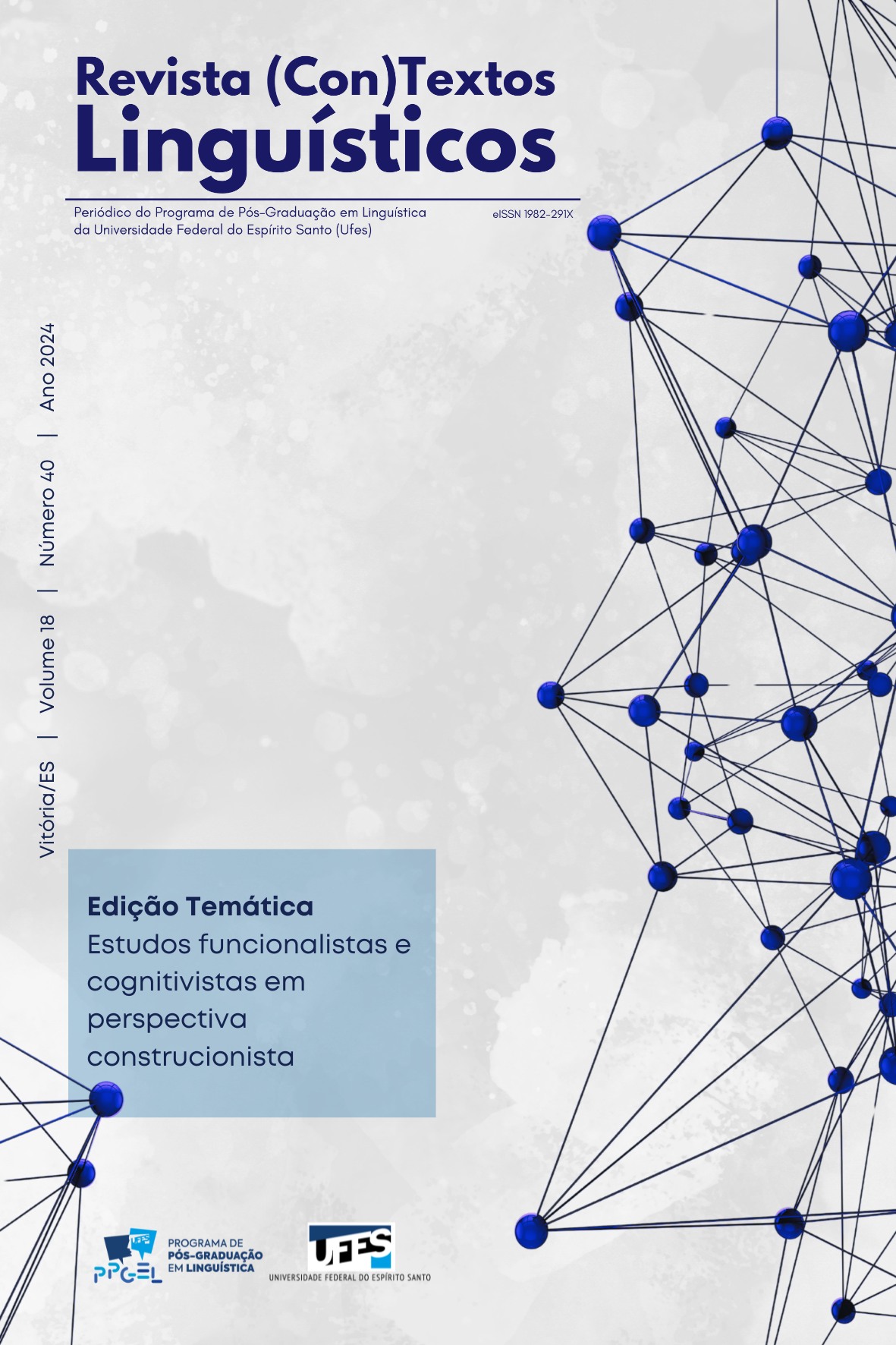“Tá de brincadeira!”
análise de um padrão construcional idiomático do português brasileiro
DOI:
https://doi.org/10.47456/rctl.v18i40.44773Palavras-chave:
Linguística Funcional Centrada no Uso, Gramática de Construções, Padrão construcional, Idiomatismo, [tá [de X]]Resumo
Neste artigo, investigamos um padrão construcional do Português Brasileiro, [tá [de X]], expresso por meio de construtos como tá de brincadeira, tá de mimimi, tá de sacanagem, dentre outros, os quais têm sido frequentes na rede social X. Nosso intuito é descrever a configuração formal e funcional desse padrão, analisando-o em termos das propriedades de esquematicidade, produtividade e composicionalidade, e compreender os contextos de uso em que é instanciado. A fundamentação teórica repousa em dois pilares essenciais: a Linguística Funcional Centrada no Uso (Tomasello, 2005; Furtado da Cunha; Bispo; Silva, 2013; Bybee, 2010) e a Gramática de Construções (Goldberg, 2006; Traugott, Trousdale, 2013). Em termos metodológicos, este estudo é de caráter descritivo-explicativo, com abordagem qualitativa e quantitativa. Com base nos achados empíricos, observamos que o padrão construcional examinado é parcialmente esquemático, com um slot semiaberto preenchido preferencialmente por elemento nominal. Esse idiomatismo pode licenciar sentidos relacionados a indignação, frustração, tranquilidade e outros.
Downloads
Referências
BYBEE, J. Language, usage and cognition. Cambridge University Press, 2010.
CASTILHO, A. T. Nova gramática do português brasileiro. São Paulo: Contexto, 2019.
CROFT, W. Radical construction grammar: Syntactic theory in typological perspective. Oxford University Press, USA, 2001.
FERREIRA, B. G. P. Construção relacional: estado, mudança e resultado. Dissertação (Mestrado) – Universidade Federal do Rio de Janeiro, Rio de Janeiro, 2015.
FILLMORE, C.; KAY, P.; O'CONNOR, M. C. Linguistic Society of America. Language, v. 64, n. 3, p. 501-538, 1988.
FURTADO DA CUNHA, M. A.; BISPO, E. B.; SILVA, J. R. Linguística funcional centrada no uso: conceitos básicos e categorias analíticas. In: CEZARIO, M. M.; FURTADO DA CUNHA, M. A. (org.). Linguística centrada no uso: uma homenagem a Mário Martelotta. Rio de Janeiro: Mauad X/FAPERJ, 2013. p. 13-40.
FURTADO DA CUNHA, M. A.; SILVA, J. R.; BISPO, E. B. O pareamento forma-função nas construções: questões teóricas e operacionais. Revista Linguística, n. esp., p. 55-67, 2016.
FURTADO DA CUNHA, M. A.; SILVA, J. R. Transitividade: do verbo à construção. Revista Linguística, v. 14, n. 1, p. 48-64, 2018.
FURTADO DA CUNHA, M. A.; BISPO, E. B. Pra quem é, bacalhau basta: da opacidade e produtividade das construções idiomáticas. Soletras, n. 37, p. 103-116, 2019.
FURTADO DA CUNHA, M. A.; BISPO, E. B. Linguística Funcional Centrada no Uso: caracterização teórico-metodológica e aplicação prática. In: ROSÁRIO, I. C. (org.). Metodologia da pesquisa funcionalista. Porto Velho: EDUFRO, 2023. p. 15-36.
FURTADO DA CUNHA, M. A.; CEZARIO, M. M. Conhecimento, criatividade e produtividade sob a perspectiva da Linguística Funcional Centrada no Uso. Alfa: Revista de Linguística, São José do Rio Preto, v. 67, p. e15041, 2023.
GOLDBERG, A. Constructions: A construction grammar approach to argument structure. University of Chicago Press, 1995.
HILPERT, M. Construction grammar and its application to English. Edinburgh University Press, 2014.
HILMMELMANN, N. P. Lexicalization and grammaticalization: oppositive or orthogonal? In: BISANG, W. et al. (eds.). What makes grammaticalization? Berlin: Mouton de Gruyter, 2004. p. 21-42.
HOFFMANN, T. Language and creativity: a Construction Grammar approach to
linguistic creativity. Linguistics Vanguard, Berlin, v. 5, n. 1, p. 1-10, 2019.
LACERDA, P. F. A. C. O papel do método misto na análise de processos de mudança em uma abordagem construcional: reflexões e propostas. Revista Linguíʃtica, v. 12, p. 83-101, 2016.
LOPES, M. G. Procedimentos metodológicos na análise de dados sincrônicos. In: ROSÁRIO, I. C. (org.). Introdução à Linguística Funcional Centrada no Uso: teoria, método e aplicação. Rio de Janeiro: EDUFF, 2022. p. 266-308.
LOPES, M. G. ROSÁRIO, Ivo da Costa. Metodologia da pesquisa sincrônica. In: ROSÁRIO, I. C. (org.). Metodologia da pesquisa funcionalista. Porto Velho: EDUFRO, 2023. p. 37-56.
LUCENA, N. L. A construção transitiva no PB: uma abordagem funcional centrada no uso. 2016. Tese. (Doutorado em Estudos da Linguagem) – Programa de Pós-graduação em Estudos da Linguagem, Universidade Federal do Rio Grande do Norte, Natal, 2016.
OLIVEIRA, M. R. Arbitrariedade e iconicidade: (inter)subjetividade, metáfora e metonímia. In: Introdução à Linguística Funcional Centrada no Uso: teoria, método e aplicação. Rio de Janeiro: EDUFF, 2022. p. 92-127.
PEREK, F. Argument structure in usage-based construction grammar. Argument Structure in Usage-Based Construction Grammar, p. 1-256, 2015.
PINHEIRO, D. Sintaxe construcionista. In: OTHERO, G. Á.; KENEDY, E. (org.). Sintaxe, sintaxes: uma introdução. São Paulo: Contexto, 2015. p.163-184.
ROSÁRIO, I. C. Introdução à Linguística Funcional Centrada no Uso: teoria, método e aplicação. Rio de Janeiro: EDUFF, 2022.
ROSÁRIO, I. C. (org.). Metodologia da pesquisa funcionalista. Porto Velho: EDUFRO, 2023.
TANTUCCI, V. Language and social minds: The semantics and pragmatics of intersubjectivity. Cambridge University, 2021.
TOMASELLO, M. (ed.). The new psychology of language. New Jersey: Lawrence Erlbaum, 1998.
TRAUGOTT, E. C. (Inter)subjectivity and (Inter)subjectification: a reassessment. In: DAVIDSE, K.; VANDELANOTTE, L.; CUYCKENS, H. (org.). Subjectification, intersubjectification and grammaticalization. Berlin/New York: Walter de Gruyter, 2010, p. 29-71.
TRAUGOTT, E. C.; TROUSDALE, G. Constructionalization and constructional changes. New York: Oxford University Press, 2013.
Downloads
Publicado
Edição
Seção
Licença
Copyright (c) 2024 Revista (Con)Textos Linguísticos

Este trabalho está licenciado sob uma licença Creative Commons Attribution-NonCommercial 4.0 International License.
Autores cedem os direitos autorais do artigo à editora da Revista (Con)Textos Linguísticos (Programa de Pós-Graduação em Linguística da Ufes), caso a submissão seja aceita para publicação. A responsabilidade do conteúdo dos artigos é exclusiva de seus autores. É proibida a submissão integral ou parcial do texto já publicado na revista a qualquer outro periódico.
Esta obra está sob Creative Commons Attribution-NonCommercial 4.0 International License.



